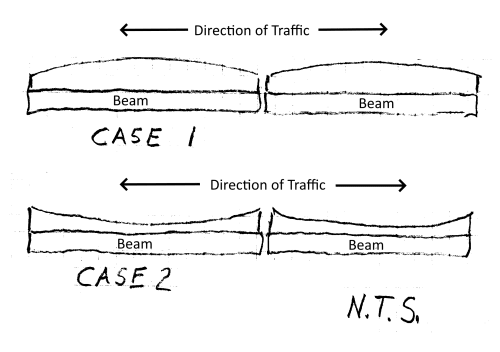tmalik3156
Structural
Good day all.
I am required to prepare a table of screed elevations for a bridge deck. These are the steps I am thinking of in my calculation. Kindly advise if this is correct and complete.
Step 1: From proposed final roadway centreline elevations, subtract thickness of asphalt to get top-of-concrete elevations. Do this for ten points in one span. These are screed points.
Step 2: Do a structural analysis of the centre girder (bare girder only – not composite) subjected to following dead loads. Use the girder’s tributary width for the weight of wet concrete and weight of asphalt. Also include the parapet and sidewalk weight (assumed smeared equivalently over the entire deck) in the girder’s tributary width.
(Some people say only include wet concrete weight ??)
Find the deflection at each of the screed points.
Do not include girder self weight. This is because girder self weight deflection is already included in the camber.
Step 3: Add these deflection values to the top-of-concrete elevations of Step 1. The resulting elevations are screed point elevations above the center girder.
Step 4: From known transverse slope of the deck from the center (crown), calculate screed elevations along other lines of girders, and along the edge of the parapet (where screed rail will be placed).
If anyone can share guidelines, spreadsheets, or example calculations, that will also be much appreciated
Thank you
I am required to prepare a table of screed elevations for a bridge deck. These are the steps I am thinking of in my calculation. Kindly advise if this is correct and complete.
Step 1: From proposed final roadway centreline elevations, subtract thickness of asphalt to get top-of-concrete elevations. Do this for ten points in one span. These are screed points.
Step 2: Do a structural analysis of the centre girder (bare girder only – not composite) subjected to following dead loads. Use the girder’s tributary width for the weight of wet concrete and weight of asphalt. Also include the parapet and sidewalk weight (assumed smeared equivalently over the entire deck) in the girder’s tributary width.
(Some people say only include wet concrete weight ??)
Find the deflection at each of the screed points.
Do not include girder self weight. This is because girder self weight deflection is already included in the camber.
Step 3: Add these deflection values to the top-of-concrete elevations of Step 1. The resulting elevations are screed point elevations above the center girder.
Step 4: From known transverse slope of the deck from the center (crown), calculate screed elevations along other lines of girders, and along the edge of the parapet (where screed rail will be placed).
If anyone can share guidelines, spreadsheets, or example calculations, that will also be much appreciated
Thank you

